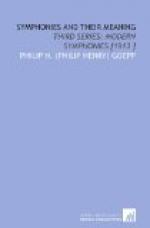with an expressive strain in some voice of the woodwind or a ripple of the harp, it is sung in tense chorus of lower wood and horns,—soon joined by all the voices but the martial brass, ending with a soft echo of the strings.
Now in full majesty the stern stride of first theme is resumed, in faster insistence,—no longer the mere tune, but a spirited extension and discussion, with retorts between the various choirs. Here the melodious march is suddenly felt in the bass (beneath our feet, as it were) of lowest brass and strings, while the noisy bustle continues above; then, changing places, the theme is above, the active motion below.
Long continues the spirited clatter as of warlike march till again returns the melting mood of the companion melody, now sung by the expressive horn, with murmuring strings. And there are enchanting flashes of tonal light as the song passes to higher choirs. The lyric theme wings its rapturous course to a blissful height, where an intrusion of the main motive but halts for the moment the returning tender verse.
When the first vigorous phrase returns in full career, there is somehow a greater warmth, and the dulcet after-strain is transfigured in a glow greater almost than of the lyric song that now follows with no less response of beauty. In the final spirited blending of both melodies the trumpets sound a quicker pace of the main motive.
In the Andante (tranquillo) the sweet tinkle of church-bells with soft chanting horns quickly defines the scene. Two voices of the strings, to the
[Music: (Bells and harp in continuous repetition) Andante tranquillo Espress. (Cellos) (Strings, with added choir of lower reeds)]
continuing hum of the bells, are singing a responsive song that rises in fervor as the horns and later the woodwind join the strings. Anon will sound the simple tune of the bells with soft harmonies, like echoes of the song,—or even the chant without the chimes.
In more eager motion,—out of the normal measure of bells and hymn, breaks a new song in minor with a touch of passion, rising to a burst of ardor. But it passes, sinking away before a new phase,—a bucolic
[Music: Poco piu mosso
(Oboe)
(Clar’ts & horns)
(Strings)]
fantasy of trilling shepherd’s reed (in changed, even pace), supported by strumming strings. The sacred calm and later passion have yielded to a dolorous plaint, like the dirge of the Magyar plains. Suddenly the former fervor returns with strains of the second melody amidst urging motion (in the triple pace) and startling rushes of harp-strings. At the height, trumpets blare forth the first melody, transformed from its earlier softness, while the second presses on in higher wood and strings; the trombones relieve the trumpets, with a still larger chorus in the romantic song; in final exaltation, the basses of brass and strings sound the first melody, while the second still courses in treble voices.




